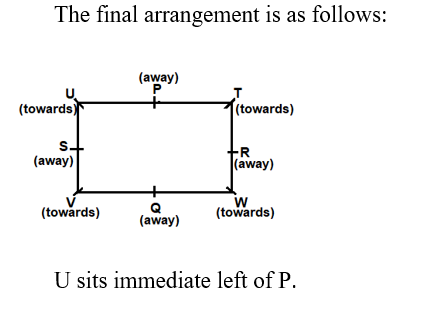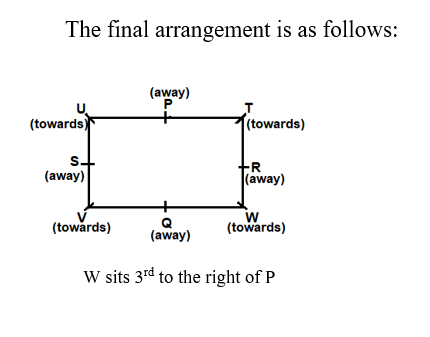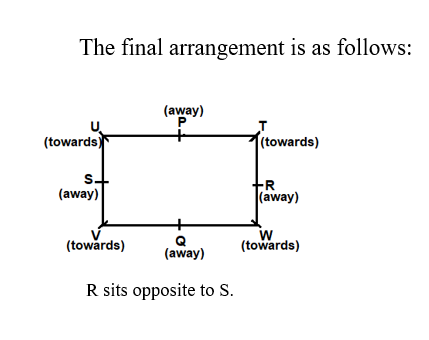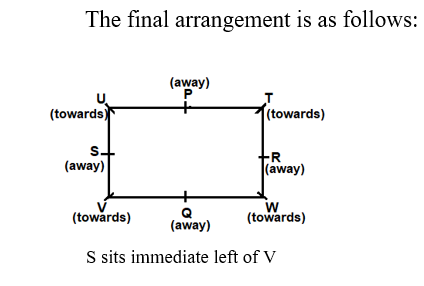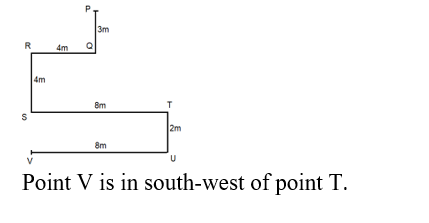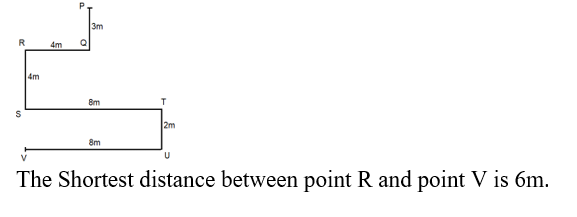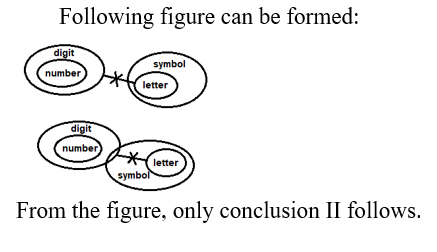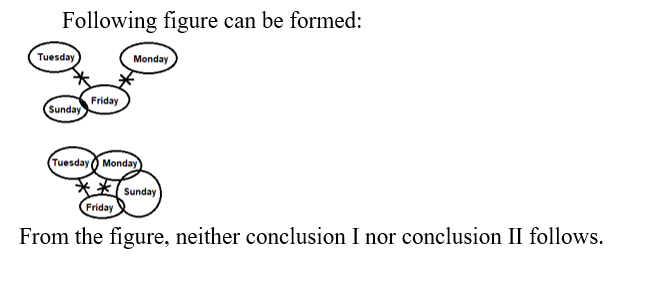Question 1:
निर्देश : नीचे दी गई जानकारी के आधार पर प्रश्नों के उत्तर दें।
Directions : Answer the questions based on the information given below.
आठ व्यक्ति P, Q, R, S, T, U, V और W एक आयताकार मेज के चारों ओर इस तरह बैठे हैं कि उनमें से चार चार कोनों पर बैठते हैं जबकि अन्य चार प्रत्येक भुजा के बीच में बैठते हैं। जो चारों कोनों पर बैठते हैं वे केंद्र की ओर मुख करके बैठते हैं जबकि जो भुजाओं के बीच में बैठते हैं वे केंद्र से दूर मुख करके बैठते हैं।
Eight persons P, Q, R, S, T, U, V and W are sitting around a rectangular table in such a way that four of them sit at four corners while the other four sit in the middle of each side. Those, who sit at the four corners face towards the centre while those who sit in the middle of the sides face away from the centre.
T, Q के बाएं तीसरे स्थान पर बैठता है। U और Q के बीच दो व्यक्ति बैठते हैं। S, U के ठीक दाएं बैठता है। V, W के बाएं दूसरे स्थान पर बैठता है। W, R का निकटतम पड़ोसी है, जो केंद्र से दूर मुख करके बैठता है। P, S का निकटतम पड़ोसी नहीं है। Q छोटी भुजा पर नहीं बैठता है।
T sits third to the left of Q. Two persons sit between U and Q. S sits to the immediate right of U. V sits second to the left of W. W is an immediate neighbor of R, who faces away from the centre. P is not an immediate neighbor of S. Q doesn’t sit on shorter side.
R के बाएं से तीसरे स्थान पर कौन बैठा है?
Who sits third to the left of R?
Question 2:
निर्देश : नीचे दी गई जानकारी के आधार पर प्रश्नों के उत्तर दें।
Directions : Answer the questions based on the information given below.
आठ व्यक्ति P, Q, R, S, T, U, V और W एक आयताकार मेज के चारों ओर इस तरह बैठे हैं कि उनमें से चार चार कोनों पर बैठते हैं जबकि अन्य चार प्रत्येक भुजा के बीच में बैठते हैं। जो चारों कोनों पर बैठते हैं वे केंद्र की ओर मुख करके बैठते हैं जबकि जो भुजाओं के बीच में बैठते हैं वे केंद्र से दूर मुख करके बैठते हैं।
Eight persons P, Q, R, S, T, U, V and W are sitting around a rectangular table in such a way that four of them sit at four corners while the other four sit in the middle of each side. Those, who sit at the four corners face towards the centre while those who sit in the middle of the sides face away from the centre.
T, Q के बाएं तीसरे स्थान पर बैठता है। U और Q के बीच दो व्यक्ति बैठते हैं। S, U के ठीक दाएं बैठता है। V, W के बाएं दूसरे स्थान पर बैठता है। W, R का निकटतम पड़ोसी है, जो केंद्र से दूर मुख करके बैठता है। P, S का निकटतम पड़ोसी नहीं है। Q छोटी भुजा पर नहीं बैठता है।
T sits third to the left of Q. Two persons sit between U and Q. S sits to the immediate right of U. V sits second to the left of W. W is an immediate neighbor of R, who faces away from the centre. P is not an immediate neighbor of S. Q doesn’t sit on shorter side.
P के सन्दर्भ में W का स्थान क्या है?
What is the position of W with respect to P?
Question 3:
निर्देश : नीचे दी गई जानकारी के आधार पर प्रश्नों के उत्तर दें।
Directions : Answer the questions based on the information given below.
आठ व्यक्ति P, Q, R, S, T, U, V और W एक आयताकार मेज के चारों ओर इस तरह बैठे हैं कि उनमें से चार चार कोनों पर बैठते हैं जबकि अन्य चार प्रत्येक भुजा के बीच में बैठते हैं। जो चारों कोनों पर बैठते हैं वे केंद्र की ओर मुख करके बैठते हैं जबकि जो भुजाओं के बीच में बैठते हैं वे केंद्र से दूर मुख करके बैठते हैं।
Eight persons P, Q, R, S, T, U, V and W are sitting around a rectangular table in such a way that four of them sit at four corners while the other four sit in the middle of each side. Those, who sit at the four corners face towards the centre while those who sit in the middle of the sides face away from the centre.
T, Q के बाएं तीसरे स्थान पर बैठता है। U और Q के बीच दो व्यक्ति बैठते हैं। S, U के ठीक दाएं बैठता है। V, W के बाएं दूसरे स्थान पर बैठता है। W, R का निकटतम पड़ोसी है, जो केंद्र से दूर मुख करके बैठता है। P, S का निकटतम पड़ोसी नहीं है। Q छोटी भुजा पर नहीं बैठता है।
T sits third to the left of Q. Two persons sit between U and Q. S sits to the immediate right of U. V sits second to the left of W. W is an immediate neighbor of R, who faces away from the centre. P is not an immediate neighbor of S. Q doesn’t sit on shorter side.
S के विपरीत कौन बैठा है?
Who sits opposite to S?
Question 4:
निर्देश : नीचे दी गई जानकारी के आधार पर प्रश्नों के उत्तर दें।
Directions : Answer the questions based on the information given below.
आठ व्यक्ति P, Q, R, S, T, U, V और W एक आयताकार मेज के चारों ओर इस तरह बैठे हैं कि उनमें से चार चार कोनों पर बैठते हैं जबकि अन्य चार प्रत्येक भुजा के बीच में बैठते हैं। जो चारों कोनों पर बैठते हैं वे केंद्र की ओर मुख करके बैठते हैं जबकि जो भुजाओं के बीच में बैठते हैं वे केंद्र से दूर मुख करके बैठते हैं।
Eight persons P, Q, R, S, T, U, V and W are sitting around a rectangular table in such a way that four of them sit at four corners while the other four sit in the middle of each side. Those, who sit at the four corners face towards the centre while those who sit in the middle of the sides face away from the centre.
T, Q के बाएं तीसरे स्थान पर बैठता है। U और Q के बीच दो व्यक्ति बैठते हैं। S, U के ठीक दाएं बैठता है। V, W के बाएं दूसरे स्थान पर बैठता है। W, R का निकटतम पड़ोसी है, जो केंद्र से दूर मुख करके बैठता है। P, S का निकटतम पड़ोसी नहीं है। Q छोटी भुजा पर नहीं बैठता है।
T sits third to the left of Q. Two persons sit between U and Q. S sits to the immediate right of U. V sits second to the left of W. W is an immediate neighbor of R, who faces away from the centre. P is not an immediate neighbor of S. Q doesn’t sit on shorter side.
V के ठीक बाएं कौन बैठा है?
Who sits immediate left of V?
Question 5:
निर्देश : नीचे दी गई जानकारी के आधार पर प्रश्नों के उत्तर दें।
अंकित बिंदु P से दक्षिण दिशा में चलना शुरू करता है, 3 मी चलने के बाद वह बिंदु Q से दाएं मुड़ता है और बिंदु R तक 4 मी चलता है। फिर वह बाएं मुड़ता है और बिंदु S तक 4मी चलता है और फिर बाएं मुड़ता है और बिंदु T तक 8 मी चलता है। वह दाएं मुड़कर बिंदु U तक 2मी चलता है और फिर दाएं मुड़ता है और बिंदु V तक 8मी चलता है और रुक जाता है।
Directions : Answer the questions based on the information given below.
Ankit starts walking from point P in south direction, after walking 3m he turns right from point Q and walks for 4m till point R. He then turns left and walks for 4m till point S and then turns left and walks for 8m till point T. He then turns right and walk for 2m till point U and then turns right and walks for 8m till point V and stops.
बिंदु T के सन्दर्भ में बिंदु V किस दिशा में है?
In which direction is point V with respect to point T?
Question 6:
निर्देश : नीचे दी गई जानकारी के आधार पर प्रश्नों के उत्तर दें।
अंकित बिंदु P से दक्षिण दिशा में चलना शुरू करता है, 3 मी चलने के बाद वह बिंदु Q से दाएं मुड़ता है और बिंदु R तक 4 मी चलता है। फिर वह बाएं मुड़ता है और बिंदु S तक 4मी चलता है और फिर बाएं मुड़ता है और बिंदु T तक 8 मी चलता है। वह दाएं मुड़कर बिंदु U तक 2मी चलता है और फिर दाएं मुड़ता है और बिंदु V तक 8मी चलता है और रुक जाता है।
Directions : Answer the questions based on the information given below.
Ankit starts walking from point P in south direction, after walking 3m he turns right from point Q and walks for 4m till point R. He then turns left and walks for 4m till point S and then turns left and walks for 8m till point T. He then turns right and walk for 2m till point U and then turns right and walks for 8m till point V and stops.
बिंदु R और बिंदु V के बीच न्यूनतम दूरी कितनी है?
What is the shortest distance between point R and point V?
Question 7:
निर्देश : निम्नलिखित प्रश्न में तीन कथन के बाद दो निष्कर्ष I और II दिए गए हैं।आपको दिए गए कथनों को सत्य मानना है भले ही वह ज्ञात तथ्यों से भिन्न भी हो और फिर यह तय करना है कि दिए गए निष्कर्षों में से कौन सा निष्कर्ष इन कथनों का तर्कसंगत अनुसरण करता है।
Direction : In the question below there are three statements followed by two conclusions I and II. You have to take the three given statements to be true even if they seem to be at variance from commonly known facts and then decide which of the given conclusions logically follows from the three statements disregarding commonly known facts.
कथन: सभी नम्बर डिजिट है
Statements: All number is digit
No digit is letter कोई भी डिजिट लेटर नहीं है
Every letter is symbol प्रत्येक लेटर सिंबल है
निष्कर्ष: I. कुछ नम्बर सिंबल है
Conclusions: I. A few number is symbol
II. Some symbol being digit is a possibility कुछ सिंबल के डिजिट होने की एक संभावना है
Question 8:
निर्देश : निम्नलिखित प्रश्न में तीन कथन के बाद दो निष्कर्ष I और II दिए गए हैं।आपको दिए गए कथनों को सत्य मानना है भले ही वह ज्ञात तथ्यों से भिन्न भी हो और फिर यह तय करना है कि दिए गए निष्कर्षों में से कौन सा निष्कर्ष इन कथनों का तर्कसंगत अनुसरण करता है।
Direction : In the question below there are three statements followed by two conclusions I and II. You have to take the three given statements to be true even if they seem to be at variance from commonly known facts and then decide which of the given conclusions logically follows from the three statements disregarding commonly known facts.
कथन: कोई भी मंगलवार शुक्रवार नहीं है
Statements: No Tuesday is Friday
Only a few Friday is Sunday केवल कुछ शुक्रवार रविवार है
None of the Friday is Monday कोई भी शुक्रवार सोमवार नहीं है
निष्कर्ष: I. कुछ रविवार सोमवार है
Conclusions: I. Some Sunday is Monday
II. No Monday is Tuesday कोई भी सोमवार मंगलवार नहीं है
Question 9:
दिए गए समीकरण को इस तरह से पूरा करने के लिए कि P>S और Q<P निश्चित रूप से सत्य हैं निम्नलिखित में से कौन-सा तत्व का समूह क्रमशः प्रश्नवाचक चिह्न के स्थान पर (बाएं से दाएं समान क्रम में) रखा जाना चाहिए?
Which of the following set of elements should be placed in the place of question marks respectively (in same order from left to right) in order to complete the given expression in such a manner that P>S and Q<P are definitely true?
_ > _ < _ < _ ≥ _ > _
Question 10:
प्रश्न में, कुछ तत्वों के बीच संबंध कथनों में दर्शाया गया है। इन कथनों के बाद दो निष्कर्ष निकलते हैं। कथनों को पढ़ें और उत्तर दें।
In the question, relationship between some elements is shown in the statements (s). These statements are followed by two conclusions. Read the statements and give answer.
कथन : Statements: C ≤ S ≥ K> U; O > J ≥ X ≥ S
निष्कर्ष: Conclusions: I. J ≥ K II. O > U

